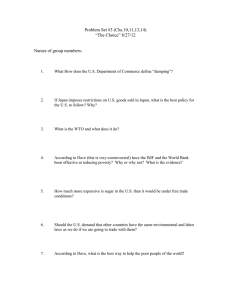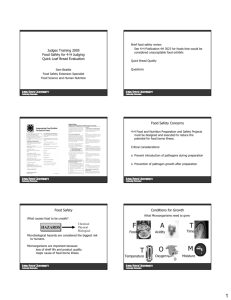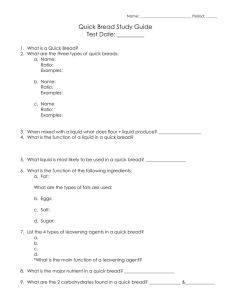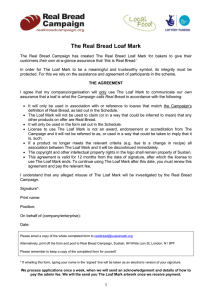1. The how’s & why’s Industrial Products (Testing)
advertisement
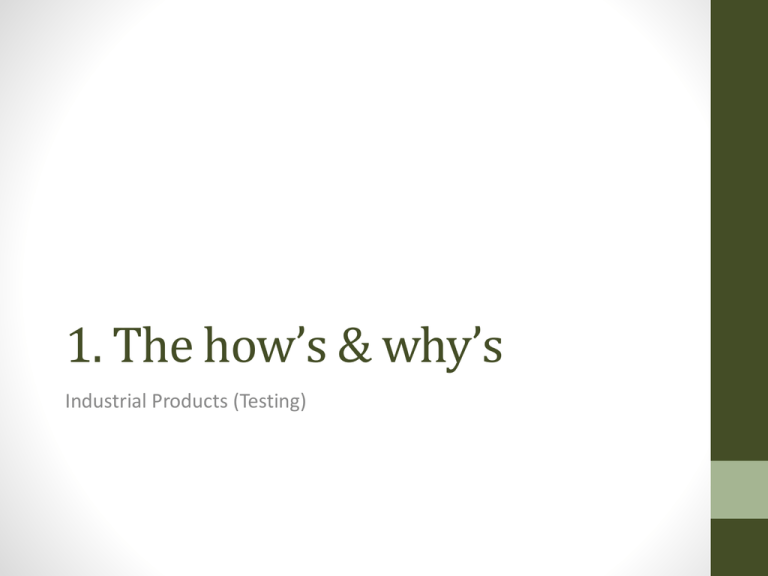
1. The how’s & why’s Industrial Products (Testing) Why test • everything is a product at some stage of the chain • consumers of a product at one stage become suppliers to the next stage • may be a number of processing steps under the category of Semi-Processed Goods • for all but the simplest of items, there will be multiple raw materials and multiple semi-processed goods Exercise 1.1 As a supplier of product, why is it necessary to test? • to make sure your product is as you claim it is • legal and sales problems otherwise As a consumer of product, why is it necessary to test? • it would be very unwise to assume that your supplier is perfect Whose responsibility is it to test the product before it is further processed? • The supplier Exercise 1.2 “ingredients” for a loaf of white bread wheat flour milled from wheat water possibly purified, rather than directly from supply yeast supplied by biochemical manufact. salt from seawater, then purified canola oil pressed from seeds sugar extracted from sugar cane, then purified soy flour milled from soy beans thiamine ?? chemical supplier plastic bags & tags plastic made from petrochemical, formed into sheets, labelled • if the bread manufacturer needed to check the quality of all the ingredients, we would be paying a lot more for our daily bread than we do Exercise 1.3 Would you expect that the bread manufacturer does no testing of the ingredients? • no • only do random checks beyond simple visual inspection • rely on supplier’s quality system 1.2 What to test for • the loaf of bread will need to be tested before it reaches the last consumer • end-of-line testing is only part of the quality process • quality control involves the checking of the partly finished product at different stages Exercise 1.4 mixing of dry ingredients, followed by addition of water • are all the ingredients included in the right amounts formation of dough • is it at the right consistency division of the dough into loaf portions • are the tins filled up correctly Exercise 1.4 cont’d controlled temperature/humidity conditions for the rising of the dough • are the settings for temperature & humidity levels correct • is the bread rising properly baking • is the oven the right temperature • is the conveyor belt moving at the right speed • has the bread cooked properly • does it taste right bagging • is the bread fitting into the bag properly • is the tag going on correctly • • • • • • • certain tests will be carried out on every item for other tests, it must be done on selected samples how often samples are taken and how much is taken product testing is far more than just chemical or microbiological analysis it is about product performance consumers not all that interested in the exact % protein they will care about how the bread tastes etc Exercise 1.5 What do you think a loaf of bread should be tested for? And how often? Every loaf • metal fragments • basic appearance Some loaves every hour (or so) • moisture content • bagging • taste Once a shift • bacterial contamination Every so often • other contamination • chemical composition • • • • testing needs a comparison point to make a judgement against a product specification or standard describes the product in fine detail gives upper and lower limits for its performance & composition Exercise 1.6 Where would the detail for a product specification come from? • internal – based on the design of the product • customer – if it is a major contract, the customer will require certain characteristics • government – legal requirements, eg Food Standards Code Who does the testing • complex work done by outsourcing CLASS EXERCISE 1.7 Let’s return to the bread manufacturer. Who will actually carry the testing we have identified as being necessary? • line operators • simple checks, such as masses, temperatures, visual checks, taste • in-house laboratory • slightly more complex tests, eg moisture content • commercial laboratory • expensive/complex tests, eg microbiological Sampling • individual items can be sampled by random or stratified selection • bulk materials are more difficult • how much • where from • what with • Australian Standards or in-house procedures CLASS EXERCISE 1.8 What is the difference between the gross sample, laboratory sample and analytical sample? How do you obtain one from the other? • gross – the large quantity of material directly taken from the bulk • laboratory – the material that comes into the lab for testing • analytical – the portion that is actually analysed • Gross to laboratory – mixing, division, homogenising • Laboratory to analytical – division How to test • • • • standard methods saves development work easier to prove to NATA inspectors that it is a valid method validated in-house procedures Sample preparation • produce a sample that can be conveniently and accurately analysed • remove some or all of the matrix from the analyte • what type of sample preparation is required: • the physical state of the sample – if is already a liquid, that makes life much easier • the nature of the analyte – is it inorganic or organic/molecular? • the nature of the matrix – if it is relatively simple, then little preparation may be required CLASS EXERCISE 1.9 What types of sample preparation will be suitable for organic/molecular analytes? • extraction • distillation • filtration/centrifuging What types of sample preparation will be suitable for inorganic analytes? • acid digestion (wet ashing) • dry ashing


